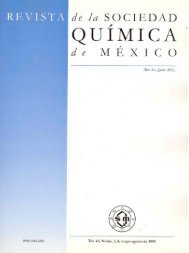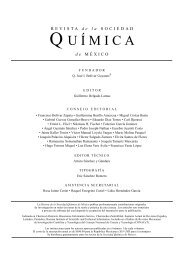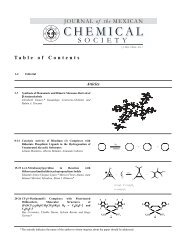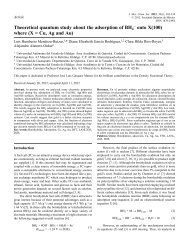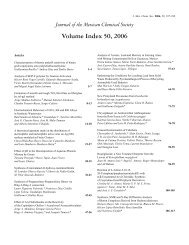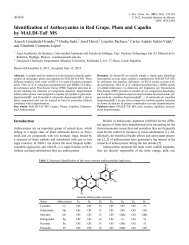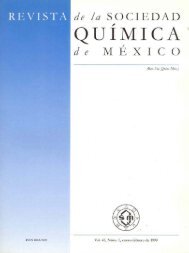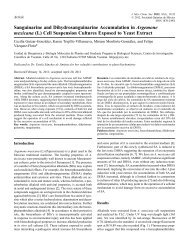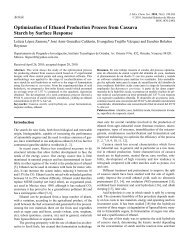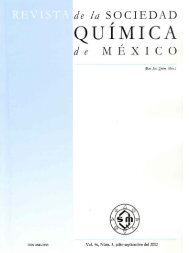SMQ-V047 N-002_ligas_size.pdf - Journal of the Mexican Chemical ...
SMQ-V047 N-002_ligas_size.pdf - Journal of the Mexican Chemical ...
SMQ-V047 N-002_ligas_size.pdf - Journal of the Mexican Chemical ...
Create successful ePaper yourself
Turn your PDF publications into a flip-book with our unique Google optimized e-Paper software.
Mechanism <strong>of</strong> Glutamate Neurochemistry: Electron Transfer and Reactive Oxygen Species 149<br />
Although <strong>the</strong> syn<strong>the</strong>tic counterpart (2c) fits into <strong>the</strong> cyclic<br />
imino acid category, it is deficient in lacking an N-alkyl containing<br />
substituent and a second carboxyl group.<br />
The favorable influence shown by 10 and 11 may result<br />
from assistance in coplanarity for <strong>the</strong> radical anion formed<br />
from <strong>the</strong> proposed imine metabolite on electron uptake, thus<br />
promoting resonance stabilization. There is widespread presence<br />
<strong>of</strong> a γ-carboxyl group in <strong>the</strong> various neurotransmitters,<br />
whose role has not been delineated, perhaps as a site binder.<br />
In <strong>the</strong> acyclic structures, <strong>the</strong> γ-carboxyl may decrease adverse<br />
steric interaction with <strong>the</strong> o<strong>the</strong>r carboxyl by association with<br />
iminium nitrogen, as depicted in 12, but not as effectively as<br />
for <strong>the</strong> covalent cyclic category.<br />
Captodative effect<br />
Various reports have shown that carbon radicals benefit from<br />
enhanced stabilization when attached to both an electron withdrawing<br />
and electron donating substituent [30]. As a result,<br />
<strong>the</strong> combined influence is synergistic. Investigators predicted<br />
that this effect would find application in vivo [30]. The following<br />
examples can be cited: paraquat, flavins and quinones<br />
[22]. The captodative radical formed from one- electron<br />
reduction <strong>of</strong> α-iminium carboxylic acid is depicted in 13.<br />
Future studies with model compounds 2c and 2e might<br />
provide fur<strong>the</strong>r insight into mechanistic aspects. The unifying<br />
<strong>the</strong>me <strong>of</strong> ET and ROS in neurochemistry is fur<strong>the</strong>r elaborated<br />
in a review [31] dealing with nitric oxide, catecholamines, and<br />
Glu.<br />
Experimental<br />
O<br />
HN..<br />
HO<br />
.<br />
12<br />
δ+ δ-<br />
O<br />
H<br />
R<br />
+<br />
H<br />
O N<br />
13<br />
Syn<strong>the</strong>sis <strong>of</strong> 1,4,5,6-tetrahydro-6-oxo-3-pyridazine carboxylic<br />
acid methyl ester (2b). α-Ketoglutaric acid (1.61g,<br />
11 mmol) and hydrazine dihydrochloride (1.16g, 11 mmol)<br />
were stirred toge<strong>the</strong>r in methanol at room temperature<br />
overnight. Following removal <strong>of</strong> solvent under reduced pressure,<br />
<strong>the</strong> residue was dissolved in dichloromethane and<br />
washed with water. After <strong>the</strong> organic phase was dried over<br />
O<br />
-<br />
O<br />
anhydrous sodium sulfate, removal <strong>of</strong> solvent gave a colorless<br />
solid (1.37 g, 80 % yield). mp. 120-125 °C; IR (KBr) 3138,<br />
2938, 1714, 1622, 1435, 1287, 1206, 1000 cm –1 ; 1 H NMR<br />
(200 MHz, CDCl 3 ) δ 3.91( s, 3H), 2.86 ( t, 3H, J=8.0Hz), 2.60<br />
(t, 3H, J=8.0Hz) ppm; EIMs: 156 (100 %), 124.<br />
1,4,5,6-Tetrahydro-6-oxo-3-pyradazinecarboxylic acid<br />
(2c). The above ester (2b) (0.5g) was hydrolyzed with 10 %<br />
methanolic sodium hydroxide and neutralized with DOWEX<br />
cation exchange resin to give <strong>the</strong> acid (2c) in quantitative<br />
yield. mp. 194-196 °C; IR ( KBr) 3382, 1720; 1 H NMR ( 200<br />
MHz, CDCl 3 ) δ 10.85 (s, 1H), 2.84 (t, 2H, J= 8.0 Hz), 2.48 ( t,<br />
2H, J=8 Hz) ppm. Prior syn<strong>the</strong>sis: α-Ketoglutaric acid and<br />
hydrazine [32,33], lit. [34] mp.194 °C for 2c.<br />
Syn<strong>the</strong>sis <strong>of</strong> 2-(Hydroxyimino)pentanedioic acid dimethyl<br />
ester (2d) and 2-(Hydroxyimino)pentanedioic acid (2e)<br />
[35]. α-Ketoglutaric acid (1.61 g, 11 mmol) and hydroxylamine<br />
hydrochloride (0.77 g, 11 mmol) were dissolved in<br />
methanol (20 mL) and stirred overnight at room temperature.<br />
After solvent was removed under reduced pressure, <strong>the</strong><br />
residue was dissolved in dichloromethane and <strong>the</strong> organic<br />
phase was washed with water. The organic phase was dried<br />
over anhydrous sodium sulfate and removal <strong>of</strong> solvent gave a<br />
viscous liquid which on triturating with diethyl e<strong>the</strong>r gave a<br />
crystalline solid (1.76g, 85 % yield). The crude solid was separated<br />
on Chromatotron using dichloromethane: methanol (3<br />
%) as eluting solvent to give (2d) and (2e) in 30 and 45 %<br />
yields, respectively, which were characterized as follows:<br />
2-(Hydroxyimino)pentanedioic acid dimethyl ester (2d).<br />
[35]. Colorless solid (30 %); mp 113-115 °C; IR(KBr) 3382,<br />
2956, 1733, 1442, 1127, 1035, 801 cm –1 ; 1 H NMR (200 MHz,<br />
CDCl 3 ) δ 3.70 (s, 3H ), 3.60 (s, 3H), 2.82 ( t, 2H, J= 8.0 Hz),<br />
2.52 ( t, 2H, J= 8.0 Hz) ppm; 13 C (50 MHz, CDCl 3 ) δ 172.92,<br />
163.75, 150.87, 52.40, 51.58, 29,59, 20.03 ppm; MS (EI) 189,<br />
156 (100 %).<br />
2-(Hydroxyimino)pentanedioic acid (2e) [36]. Colorless<br />
solid (45 %); mp. 152-153 °C; lit. [36] mp. 152 °C. IR (KBr)<br />
3422, 1734, 1666, 1448, 1029, 635 cm –1 ; 1 H NMR (200 MHz,<br />
CDCl 3 ) δ 12.16 ( 2H), 2.83 (t, 3H J= 8.00 Hz), 2.52 ( t, 2H, J=<br />
8.0 Hz) ppm.<br />
References<br />
1. Kovacic, P.; Becvar, L.E. Curr. Pharmaceut. Des. 2000, 6, 143-<br />
167.<br />
2. Kovacic, P.; Osuna, J.A. Curr. Pharmaceut. Des. 2000, 6, 277-<br />
309.<br />
3. Kovacic, P.; Jacintho, J.D. Curr. Med. Chem. 2001, 8, 773-796.<br />
4. Kovacic, K.; Jacintho, J.D. Curr. Med. Chem. 2001, 8, 863-892.<br />
5. Kovacic, P.; Sacman, A.; Wu-Weis, M. Curr. Med. Chem. 2<strong>002</strong>,<br />
9, 823-847.<br />
6. Poli, G.; Cheeseman, K.H.; Bianzani, M.U.; Slater, T.F. Eds.<br />
Free Radicals in <strong>the</strong> Pathogenesis <strong>of</strong> Liver Injury. Pergamon<br />
Press, New York. 1989.




